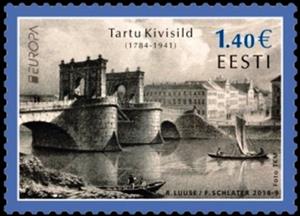Stamp: Europa 2018 : Bridges (Estonia 2018)
Europa 2018 : Bridges (Estonia 2018)
03 May (Estonia ) within release Europa (C.E.P.T.) 2018 - Bridges goes into circulation Stamp Europa 2018 : Bridges face value 1.40 Euro
| Stamp Europa 2018 : Bridges in catalogues | |
|---|---|
| Michel: | Mi: EE 919 |
Stamp is horizontal format.
Also in the issue Europa (C.E.P.T.) 2018 - Bridges:
- Stamp - Europa 2018 : Bridges face value 1.40;
- Stamp - Europa 2018 : Bridges face value 1.40;
- Full Pane - Europa 2018 - Arch Bridge, Tartu face value 10*1.40;
- Full Pane - Europa 2018 - Stone Bridge, Tartu face value 10*1.40;
Stamp Europa 2018 : Bridges it reflects the thematic directions:
Architecture (Latin architectura, from the Greek ἀρχιτέκτων arkhitekton "architect", from ἀρχι- "chief" and τέκτων "builder") is both the process and the product of planning, designing, and constructing buildings and other physical structures. Architectural works, in the material form of buildings, are often perceived as cultural symbols and as works of art. Historical civilizations are often identified with their surviving architectural achievements.
A bridge is a structure built to span physical obstacles without closing the way underneath such as a body of water, valley, or road, for the purpose of providing passage over the obstacle. There are many different designs that each serve a particular purpose and apply to different situations. Designs of bridges vary depending on the function of the bridge, the nature of the terrain where the bridge is constructed and anchored, the material used to make it, and the funds available to build it.
A castle (from Latin: castellum) is a type of fortified structure built in Europe and the Middle East during the Middle Ages by European nobility. Scholars debate the scope of the word castle, but usually consider it to be the private fortified residence of a lord or noble. This is distinct from a palace, which is not fortified; from a fortress, which was not always a residence for nobility; and from a fortified settlement, which was a public defence – though there are many similarities among these types of construction. Usage of the term has varied over time and has been applied to structures as diverse as hill forts and country houses. Over the approximately 900 years that castles were built, they took on a great many forms with many different features, although some, such as curtain walls and arrowslits, were commonplace.



